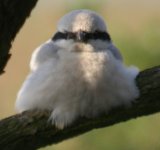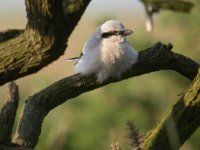CJW
Hit-and-run WUM
I think that is a little over-simplified Michael, but can't 'argue' from a position of knowledge (although I'm learning more about wing formulas all the time). Suffice to say you are the only person to say this. I have Emails from a person who has rung them in Kazhakstan and here's a quote from his latest communication:
"The pic showing the primaries is also very very useful. My interpretation of the primaries would be that seven primary tips are fully visible and the extreme (and worn) tip of the eighth is just visible too, and on both wings. This makes the wing point p3 (numbered ascendently). It's looking very good indeed for palidirostris, as far as I'm aware this is the only form which has the wing point at p3 as opposed to p4. I'd speculate that some (perhaps very few) homeyeri might show a similar wing formula to this though they obviously can't show the same secondary pattern as this bird."
I also have a series of video grabs of a Kazhakstani "Steppe" Grey Shrike that clearly show it to be dark-billed and dark-lored and very similar in primary projection length and overall colouration to the IOM "Southern" Grey Shrike.
A further quote from this person about the video grabs (which I'm not presently at liberty to publish) says:
"If your interested the precise location is the Taukum Sand which lie about 2/3 of the way between Almaty and the SW corner of Lake Balkhash. Only pallidirostris is thought to occur here."
I wouldn't be too keen to follow verbatim what the literature says, given what has come to light during mine and Manxman's investigations.
"The pic showing the primaries is also very very useful. My interpretation of the primaries would be that seven primary tips are fully visible and the extreme (and worn) tip of the eighth is just visible too, and on both wings. This makes the wing point p3 (numbered ascendently). It's looking very good indeed for palidirostris, as far as I'm aware this is the only form which has the wing point at p3 as opposed to p4. I'd speculate that some (perhaps very few) homeyeri might show a similar wing formula to this though they obviously can't show the same secondary pattern as this bird."
I also have a series of video grabs of a Kazhakstani "Steppe" Grey Shrike that clearly show it to be dark-billed and dark-lored and very similar in primary projection length and overall colouration to the IOM "Southern" Grey Shrike.
A further quote from this person about the video grabs (which I'm not presently at liberty to publish) says:
"If your interested the precise location is the Taukum Sand which lie about 2/3 of the way between Almaty and the SW corner of Lake Balkhash. Only pallidirostris is thought to occur here."
I wouldn't be too keen to follow verbatim what the literature says, given what has come to light during mine and Manxman's investigations.







